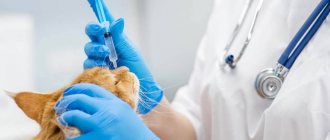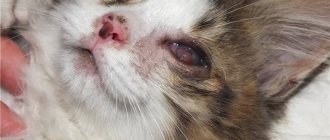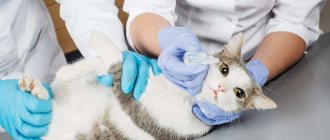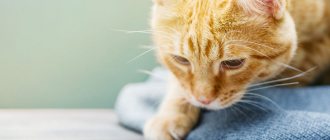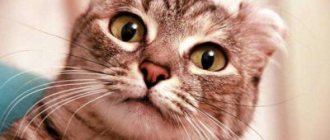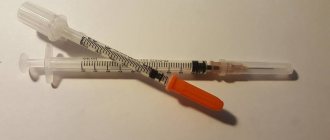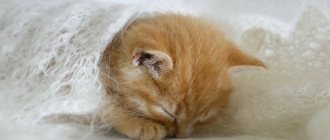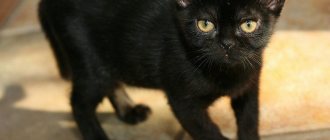Maria Alexandrovna Sazhko
veterinary therapist
Veterinarians are often asked to tell us how to wash the eyes of kittens and adult animals, so we decided to prepare a whole article on this topic.
Normally, a healthy cat or cat follows the rules of hygiene on its own, caring for the hair of the entire body, face and tail. Unfortunately, the animal is not always able to independently remove all contaminants from the eyes, skin and fur around it; in this case, the intervention of the owner is required.
It is important to always pay attention to the appearance and general condition of the pet and, if necessary, if you notice an unkempt appearance, extensive dirt or pain, immediately seek help from a doctor.
When is eye rinsing necessary?
This manipulation is necessary in a number of cases: prevention of secondary infection in case of injury, routine treatment of a contaminated eye in an animal predisposed to contamination, when removing mechanical contaminants and drug residues during treatment of an eye or systemic infection. Let's consider this issue in more detail.
Eye diseases
Conjunctivitis
– inflammation of the mucous membrane of the eye, that is, the conjunctiva, caused by a viral or bacterial infection, allergic reaction, injury, etc. Manifested by swelling of the conjunctiva, redness, active discharge and soreness.
Blepharitis
– an eye disease that affects a cat's eyelids. The eyes look swollen, discharge accumulates around them and dries into crusts, and there is itching and restlessness on the part of the animal.
Glaucoma
– this is a disease that develops as a result of increased intraocular pressure, manifested by damage to the optic nerve and retina. The chronic course of the disease can cause optic nerve atrophy, that is, lifelong blindness. The main manifestations are an increase in the volume of the eyeball, clouding, lacrimation, redness, etc.
Keratitis
– disease of the cornea of the eye. This pathology can be caused either by injury or be secondary to another eye disease. It manifests itself as swelling, lacrimation, clouding of the cornea, and when complicated by a secondary infection – itching and pain.
Cataract
– a rare disease, typical mainly for older animals, which consists of clouding of the lens of the eye. This change can be caused by chronic diseases of the animal - diabetes, trauma, intoxication, metabolic disorders, genetic predisposition, etc. Visually, this condition is noticeable only in the later stages.
Turn of the century
- A fairly rare disease in cats. This is a congenital problem or acquired as a result of long-term inflammatory processes, which is manifested by improper placement of the eyelid and eyelash margin. Most often, it turns inward, thereby constantly injuring the surface of the eye. Visually, this pathology manifests itself very characteristically, but the first thing that owners most often pay attention to is redness, increased discharge from the eyes, and anxiety.
More details about each disease can be found in the article.
Injuries
Mechanical damage to the surface of the eye most often occurs in cats that are on their own or live in contact with other animals. Injuries are caused as a result of mutilation by sharp objects, in fights, falls and other unforeseen situations.
This pathology is manifested by general inflammatory signs - discharge from the eye, swelling, anxiety on the part of the pet, pain. As a result, on the surface of the eye you can see swelling of the corneal tissue - a whitish surface. At the appointment, a doctor who suspects an eye injury conducts a fluorescein staining test. Thus, he details the extent and depth of the lesion - prognosis and further therapy depend on this.
Each disease is unique in its own way and requires an individual approach and prescription. But one thing remains common in treatment - in case of any inflammation, it is necessary to rinse the cat’s eyes and keep them clean. Before any manipulations, administration of drugs - drops or ointments, the owner must thoroughly treat the eye from mechanical impurities and secondary bacterial infections. In advanced diseases, the cat’s eyes have to be washed even to remove pus.
Anatomical features
Some cats have anatomical features of the nasolacrimal duct. For example, narrow, short, folded eye orbits, like exophthalmos, skin folds, occur in short-faced cats - Persians, exotics, Scottish folds. Owners of these cats often experience excessive tearing and tear tracks. Under the eyes of such cats, the secretion of the lacrimal gland often accumulates, in which, over time, harmful bacteria develop, causing a local inflammatory process, alopecia, itching and anxiety on the part of the animal.
It is important for such breeds to pay timely attention, treat and wash their eyes, ensure the prevention of bacterial inflammation, clean the skin and fur around them, without waiting for secondary changes.
Causes of discharge from a cat's eye
Eye problems can have devastating consequences. Therefore, as a cat owner, you should be aware that your cat has eye problems. Here are a few reasons why your cat may have eye problems:
- Respiratory infections : A common cause of eye discharge in cats can be infectious respiratory disease, pneumonitis or rhinotracheitis, feline calicivirus (FCV) and protozoa. Early signs of such infections can be very mild or very serious, such as sticky, pus-filled discharge.
- Corneal diseases : A cat's cornea is a dome-shaped surface covering the front of the eye. It can easily become inflamed, injured, or ulcerated. If you see your cat blinking excessively or having excessive tear production, your cat most likely has a corneal disease.
- Conjunctivitis : Note that if there is light pink mucous membrane around your cat's eyes that is swollen, your cat may develop a watery or thick mucous discharge from the eyes. This is not a very common sign, but conjunctivitis with fever, diarrhea and breathing problems can be a serious infection in cats.
- Dry eyes : A dry eye condition is a lack of watering in your cat's eyes. It can lead to inflammation of the cornea and red eyes, and if left untreated, it can lead to blindness. Since the eyes do not produce water, a sticky yellow discharge from the eyes may follow.
© shutterstock
How to wash the eyes of kittens and adult cats?
Folk remedies
To wash the eyes of a cat or kitten, you can use diluted infusions of tea or herbs. It is important to use solutions at a comfortable temperature that does not injure or burn.
The following options can be used:
- Strong tea or tea leaves.
To do this, you will need to brew strong tea/decoction and let it sit for 10–12 hours, or better yet, a day. It is important to use loose leaf tea or herbs, and not tea bags.
- Chamomile decoction.
One brewed bag of chamomile at room temperature is enough. It must be remembered that it can dry out the skin with frequent use.
- St. John's wort decoction.
This decoction must be used diluted.
- Calendula decoction.
An aqueous decoction made from calendula flowers. It is important to dilute it before using it for eye treatment.
Pharmacy products
You can use standard, readily available drugs from a humanitarian pharmacy.
- Sodium chloride solution 0.9%.
Standard saline solution used for intravenous administration. When used, it can be drawn up sterilely using a syringe. This way the remaining bottle will remain sterile and suitable for further use.
- Aqueous solution of chlorhexidine 0.01%.
It is important to pay attention to the concentration of the drug and the absence or presence of alcohol-containing substances in it.
- Furacillin solution 0.02%.
Also use low concentration.
Specialized means
A cat’s eyes can be washed at home with any of the following means, both as a preventive measure and in combination with medicinal drugs to treat any disease:
- "Diamond Eyes"
– a drug with chlorhexidine, taurine and chlorocide C. These cat eye drops are an antiseptic that can be used as a prophylaxis and, as a concomitant remedy, in the treatment of ophthalmic pathology.
- Eye cleaning lotion from any brand.
It is important to pay attention to the principle of use of the drug, prescribed in the instructions - usually they cannot be used against “tear paths” and in no case applied to the surface of the eye.
Hurry up, choose a box and find out what gift awaits you
Discount on pet insurance
Promo code copied to clipboard
Allergic reaction
Cats often suffer from allergies, which causes severe tearing. Other symptoms also occur; the animal suffers from nasal discharge, sneezing, and, less commonly, coughing. The causative agent of the problem can be pollen, chemicals, aerosols, medications and much more. A veterinarian will be able to determine for sure, and he will help you choose an antihistamine.
Treatment in this case includes caring for the pet’s eyes, using medications and protecting the animal as much as possible from the causative agent of the disease. Suprastin is often recommended for allergies in cats; the dosage is a quarter of a tablet, used once a day. Tavegil, Claritin, Pipolzin, Diphenhydramine are also used. All drugs are used only after prescription by a specialist and individual dosage calculation.
Common Cat Ailments
How to treat a cat if she sneezes
How to wash the eyes of an adult cat?
As auxiliary means for eye treatment, you may need:
- a pipette or syringe without a needle for applying the drug to the surface of the eye;
- a cotton pad or gauze swab (or sterile rags) - to remove dirt and excess drug;
- a blanket - as a means of humane fixation if the cat has a negative attitude towards this procedure;
- treats as positive reinforcement - encouragement.
The main thing when washing your eyes:
- Calm
It is important to approach this manipulation calmly and carefully. Under no circumstances should you grab a cat and force it to cooperate with a rough fixation - in this way you can scare it forever, and the cat will greet each procedure like a wild animal.
- Humane fixation
It's easy to pick up a calm and loving cat. But what to do with an aggressive or touch-intolerant pet? This is where a blanket with a homely scent will come to the rescue. With caring movements, you need to wrap the cat in a blanket, thereby immobilizing it and giving it a feeling of security.
- Speech
It is important to continue talking to the cat throughout the entire procedure in a calm and quiet voice, even if the cat begins to be indignant. Your speech will make it clear to the tailed one that everything is fine and nothing threatens him.
- It is necessary to drop 2-3 drops of the solution we have chosen into each eye and let the animal blink several times. This will remove excess solution through the outer corners of the eyes, as if he were crying.
- Using a rag or napkin soaked in the selected solution, you need to remove excess and dirt accumulated around the eyes. Cleanse the coat and skin with gentle massaging movements. Do not injure your eyes under any circumstances. It is important to use a separate tissue for each eye.
If necessary, the prescribed drops can be dropped into the cat's already cleaned eyes again.
Street cats
The reason for the prevalence of eye diseases among street cats is the lack of normal living conditions. Frequent fights, lack of medication, constant contact with other animals, poor diet, temperature changes and other factors cannot have a beneficial effect on recovery. As a rule, environmental conditions only aggravate the situation and lead to serious consequences.
Adopting a stray cat is easy. However, one should always be aware of the level of responsibility that a person takes on with such a decision.
In most cases, street cat diseases are in late stages, so the treatment period can take a long time and cost a lot of money.
At the same time, homeless animals are the most loyal creatures in the world, unlike many purebred animals. Such a cat will be grateful to its owner and can become his best friend.
1111
How to wash kittens' eyes?
Eye treatment for kittens is very similar to that for adult animals. The basic principle is a humane approach and gentle procedure with the aim of cleansing, but not causing further injury. For comfortable fixation, a blanket and warmth are also used; soft fixation is possible at the skin fold of the withers as an imitation of a mother cat. You should not hold the kitten suspended by the skin fold, thereby causing pain. If an adult kitten is unnerved by this approach, stop immediately.
It is enough to apply 1 drop of solution to each eye. If the kitten is very small, excess solution and dirt can be removed with a cotton swab.
After any unpleasant procedure, both an adult cat and a kitten must be rewarded with stroking, praise for good behavior and treats. In this way, we reinforce the animal’s good attitude towards any necessary manipulation - next time everything will go even easier. Doctors are wary of prescribing eye drops to kittens because of their high concentration.
Now that the question of how and what to wash the eyes of a kitten or cat at home has been discussed to the fullest, let us note what you need to pay special attention to so as not to harm your pet.
Owner's first aid
Of course, when a cat has suppuration, a veterinarian’s consultation is necessary. Only after an examination can a veterinarian make an accurate diagnosis and prescribe appropriate treatment. However, the owner must also be able to provide first aid carried out at home. First of all, rinsing is necessary.
Eye wash
How can you wash your eyes?
- Decoction of chamomile flowers.
- Boric acid solution (2 teaspoons of medicine per half liter of warm boiled water).
- 0.02% solution of furatsilin.
How to wash?
The basic rule: the solution must be warm, you cannot use it hot so that the animal does not get burned. A cotton pad, previously twisted into a tourniquet, is dipped into the medicine, which is then squeezed onto the cat’s diseased organ. You need to wash until all the pus is removed. After each wash, the cotton pads should be changed; it is best if the tourniquet is disposable.
You cannot use dry cotton wool, as it can further injure the eye. You should not replace a cotton pad with cotton swabs. Of course, they are more convenient to use, but the sticks pick up a small amount of solution. After you have finished rinsing, you need to put 1% Tetracycline ointment behind the eyelid.
We use ointment
How to properly apply revive ointment?
Before applying the ointment, it must be warmed in your hands; there is no need to make investments with a cold composition:
- One person holds the cat tightly, lying on his side.
- The other, meanwhile, carefully pulls back the animal's lower eyelid.
- Use a special spatula to apply ointment to the lower eyelid.
- Then you need to close the eye and distribute the ointment with light massaging movements.
We use drops
What drops can be used to bury a cat?
In order to treat a cat, you can use different drops, for example, Levomycetin, Sodium Sulfacyl, Diamond Eyes drops.
This is interesting: Do cats have distemper and its symptoms?
How to carry out the procedure correctly?
- The cat needs to be laid on its side, and in such a way that the eyeball is directed upward.
- In order to administer the drops, you need to hold your pet firmly so that it does not get injured.
- Drop the medicine, after which the cat will blink vigorously, and the medicine will be distributed in the eyeball.
- Then blot the area with a napkin.
Precautions
- Under no circumstances should alcohol solutions, antiseptics, or concentrates be injected into the eyes. This can cause a chemical burn to the surface of the eye.
- You cannot use plain water as a treatment - it disrupts the composition of the microflora of the eye and can dry out its surface.
- Do not use hot decoctions due to possible thermal burns.
- You should not use cotton wool or fibrous rags - the lint may get on the surface of the eye and may be difficult to remove.
- Do not use the same swab/cotton pad on both eyes. This way we can spread the infection from one eye to the other.
- Under no circumstances should treatment prescribed by a doctor be stopped without his knowledge and before the prescribed date.
How to care for your pet's eyes
It is necessary to monitor your cat's eyes starting from early childhood. The kitten opens its eyes starting from two to three weeks of age. If they do not open for a long time, you need to start treating them with gentle movements of an ear stick or a napkin moistened with one of the above solutions. It is important to remove all crusts and discharge immediately during the period of opening the eyes, which usually lasts for 2–3 days.
Normally, adult cats take care of their hygiene on their own - by licking their fur and washing their faces. It is important to pay attention to the condition of the cat’s coat - a healthy cat will always be clean, while a sick cat, on the contrary, will have a dirty, unkempt appearance. In this case, it is necessary to contact a veterinarian in a timely manner.
Prevention is important and is needed as needed - that is, in case of contamination. If the eyes and the skin around them are clean, no treatment is required.
Treatment of conjunctivitis - what to use at home?
Unlike diseases that are dangerous to a cat’s health, it is quite possible to cope with conjunctivitis on your own, making sure that there are no additional signs of serious illness. A mandatory rule for home treatment is to closely monitor the animal’s condition; if no results are observed, it is better to go to the veterinarian. Usually, drops are used for treatment, which destroy the infection that caused souring. Most often it is recommended to use Levomycetin, which copes with most types of bacteria. The peculiarity of the drug is that it does not penetrate the tissues of the eyeball or skin, acting only on the surface of the mucous membranes. Thanks to this, negative reactions or side effects are quite rare.
In addition to the use of medications, it is recommended to use home remedies that are no less effective in treating the disease. The only rule is to use home recipes only for allergic or inflammatory types of conjunctivitis. Rosehip decoction is one of the most effective remedies against sour eyes in animals. It's easy to prepare:
- Pour boiling water (200 ml) over rose hips (30 g).
- Send the container to low heat.
- Simmer covered for a quarter of an hour.
- Leave for an hour, wrapping the container in a towel.
Rinse the animal's eyes every 3-5 hours. It is convenient to do this with cotton wool discs, but remember to use a clean sponge every time. The duration of treatment is a week, usually this time is enough to cope with the disease. Sour eyes do not always indicate a serious illness, but it is better not to refuse the help of a veterinarian. Only after a specialist determines that there is no danger to the cat can you resort to home treatment and use simple remedies.
Eye wash: the main thing
- Treatment and rinsing are the main methods of first aid and prevention of secondary infection for any diseases of the eyes of a cat.
- It is important to take care of your cat's eyes, starting from a young age and throughout her life.
- There are a large number of available products that can be used to wipe the eyes of both a kitten and an adult animal: decoctions of chamomile, calendula, an aqueous solution of chlorhexidine 0.01%, a solution of furacillin 0.02%, cleaning lotions.
- When treating an animal's eyes, it is important to use strictly aqueous and low-concentrated solutions.
- A special approach to the cat during the eye washing procedure predetermines its further attitude to any other therapeutic measures. It depends on him whether her attitude will be positive or negative.
- There are anatomical features of a cat's eye that predispose it to frequent contamination - it is important to pay attention to this and prevent secondary infections by periodically treating the eyes and skin around them.
- A very small kitten can be wiped with a cotton swab; for older animals, you can use cotton pads/gauze swabs.
Prevention
The health of a pet depends on many factors, and above all, on the attentiveness of the owners. Preventive measures are also important. It’s not difficult to follow them, and the result will be, as they say, “on the face.”
If, due to his age, the kitten is not yet able to wash himself thoroughly, he needs help - washing his eyes daily with the above-mentioned chamomile decoction, strong tea, etc. If the animal has an injury to the area near the eye, it must be disinfected, and the fur nearby must be cut. It may be worth considering trimming the nails to prevent the animal from injuring itself.
In order for the animal to have a strong immune system (which also affects the condition of the eyes), it is important to feed it properly. If there are several pets living in the house, wash their eyes, just like a sick kitten - as a preventative measure
